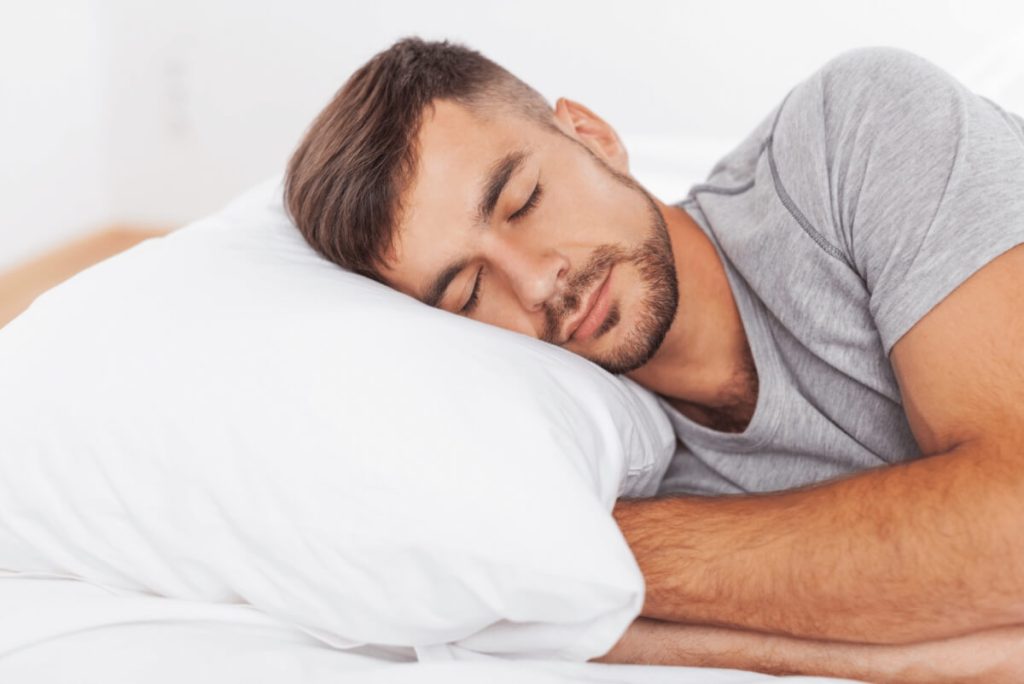
What Are The Stages Of Sleep, And Why Do You Need All Of Them For Health And Cognitive Function?


What Are The Stages Of Sleep, And Why Do You Need All Of Them For Health And Cognitive Function?
The Free Prescription
Imagine a world where doctors give you, and the most important people in your life, a free prescription that helps improve:
- Memory
- Emotional well-being
- Immunity
- Hormone function
- And the health of your heart and brain
As an added bonus, this prescription can also improve your muscle strength, help with weight loss and metabolism, and maximize your healthspan Best of all, this prescription can help you look young, healthy and leave you feeling amazing and refreshed.
This prescription exists and goes by the name of sleep. But sleep goes beyond just laying still in bed for 7 – 8 hours. Sleep quality matters too. In this article, we’ll cover what your body does while you sleep, various sleep stages, and why each stage serves specific purposes for your brain and body.

Is Sleep A Passive Or An Active Process?
Most of us perceive sleep as a passive process–you lay still through the night. But aside from saving energy from not doing daytime activities, sleep is very much an active process. For example, your brain cells need sleep to develop, and to support learning and memory. Also, the housekeeping cells in your brain clean up waste created by the brain when it’s awake.
Sleep is so crucial for human life to exist that we spend ⅓ of our life sleeping. Not getting enough sleep is associated with increased cardiovascular and metabolic health risk. Traditionally, there are four stages of sleep and the time spent in each stage changes as we age. Also, total sleep time goes down as we get older.
Feeling tired despite getting enough hours of sleep could mean you’re failing to get enough of certain stages of sleep. Or, your body doesn’t fully achieve the certain restorative processes it needs. The morning fatigue and brain fog could be signs of poor quality sleep. This explains why both sleeping too little (<5 hours) and too much (>9 hours) are associated with higher all-cause mortality.
What Are The Four Stages Of Sleep (N1, N2, N3, and REM) And Why Does Each Of Them Matter?
Have you ever seen a cute baby sleeping and noticed its eyes quickly move from side to side behind its closed eyelids repeatedly? If you have, then you’ve witnessed rapid eye movement (REM) sleep.
A good night’s sleep has a rhythmic, cyclical pattern that goes between three stages (N1, N2, N3) of non-rapid eye movement (NREM) sleep and REM sleep. About 75% of sleep is spent in the NREM stages.
This cyclical sleep pattern is known as sleep architecture and can be negatively affected by many things, such as:
- Caffeine
- Alcohol
- Noise
- Light exposure
- Being around mobile phones and bluetooth devices (for some people)
A typical night’s sleep consists of 4 to 5 sleep cycles, and progresses in the following order:
- N1
- N2
- N3
- N2
- REM
REM sleep usually arrives about an hour and a half after you fall asleep and lasts about ten minutes. Each REM stage that follows gets longer and longer, while the NREM stages get shorter and shorter.
The First Stage Of Sleep (Non-R EM 1)
After a long day at work, when you lay down on your comfortable bed, start feeling drowsy, and close your eyes, you have just entered the first stage of sleep. This stage is known as NREM stage N1. The N1 stage has no rapid eye movements, lasts up to 5 minutes and makes up about 5% of a full night’s sleep. In this stage:
- Core body temperature decreases
- Breathing tends to occur at a regular rate
- The tone of voluntary muscles remains present
- You’ll wake up easily to things like noise or bright lights
The Second Stage Of Sleep (Non-REM 2)
N2 is a slightly deeper sleep and makes up about 50% of your entire sleep (the largest percentage of total sleep time). In the N2 stage:
- Heart rate slows down
- Body temperature continues to lower
- Teeth grinding can occur
- And two special brain waves appear on an electroencephalogram (EEG), a machine that measures electrical activity in the brain. These brain waves are Sleep spindles and K complexes
Sleep spindles are brief, powerful bursts of brain cells (neurons) firing and allowing calcium ions to enter particular parts of the brain. Researchers believe sleep spindles change the strength of connections between neurons (synaptic plasticity) and may help turn short term memories into long term memories (memory consolidation). Sleep spindles are particularly important for two types of memory:
- Procedural memory, which is involved in learning habits and skills through repetition, like tying your shoes, riding a bike, or driving a car.
- Declarative memory takes part in storing information about events that have happened to us (e.g. a fun birthday party) or keeping factual knowledge (e.g. remembering the meaning of complicated words).
K complexes are long brain waves that last for about one second and also help with memory consolidation. K complexes help maintain sleep by suppressing brain activity when the body detects an environmental signal that is interpreted as being harmless (e.g. a cricket chirping). K complexes also help with waking up when the brain interprets a particular signal as potentially dangerous (e.g. a dog barking).

The Third Stage Of Sleep (Non-REM 3 or deep sleep)
N3 is also known as the slow wave sleep stage or deep sleep. It is the most difficult phase to wake up from. N3 takes up to 25% of total sleep time and some people in this stage will not wake from noises as loud as 100 decibels (this is about as loud as a lawn mower or motorcycle).
During N3 (deep sleep) stage:
- The body repairs and regrows tissues
- Builds bone and muscle
- The immune system is strengthened.
- This time spend in this stage decreases in older individuals
- Individuals awakened during this phase tend to feel groggy and not have 100% mental performance for at least an hour
- In certain people, this is where sleepwalking, night terrors, and bedwetting occurs
- The glymphatic system activates. This system was discovered about 10 years ago and is so important, that we go into greater detail a bit later in this article.
Over 90% of melatonin and growth hormones are secreted during the NREM stages of sleep. These hormones enhance the immune system, support tissue growth and help the body recover from injuries.
The Fourth Stage Of Sleep (REM or rapid eye movement)
REM sleep takes up about 25% of nighttime sleep in healthy human adults, and even more in newborns. In REM sleep:
- The eyes move rapidly from side to side under closed eyelids
- Breathing rate becomes irregular, pulse and blood pressure vary
- Brain waves during REM sleep resemble wakefulness and brain metabolism increases by up to 20%
- Like the N2 stage, REM sleep changes the strength of connections between neurons (synaptic plasticity)
- Synaptic pruning occurs, a process where the brain removes connections between neurons. More on this later.
- The brain regulates its own temperature
- The sensitivity of cell receptors to chemical signals are adjusted (modulated)
- REM-related muscle twitches help the sensorimotor system to develop. This system controls the body’s ability to perceive and respond to the external environment.
- REM sleep is mostly associated with dreaming, however dreams can occur during other stages of sleep as well
- Skeletal muscles become paralyzed, possibly to prevent people from acting out their dreams
- People that are deprived of REM sleep experience negative behavioral changes, such as anger and frustrations and can develop abnormalities in their visual system
- People are most likely to spontaneously awaken in the morning during REM sleep
REM sleep can be divided into alternating cycles of phasic and tonic REM periods. The phasic period is where people experience bursts of rapid eye movements and is geared toward promoting sleep stability.
The tonic period does not have rapid eye movement, but the brain is more alert to environmental signals. The tonic period is likely a protective mechanism that is sprinkled in between phasic periods.
Phasic periods, like the N3 stage, is a part of sleep that is difficult to wake people up from. Tonic periods can serve as brief security inspections on the environment to help protect the body against potential threats.
Essential Processes That Happen In Your Brain During Sleep

Synaptic Pruning
After you lay your head down on your pillow, your brain needs to review what happened in your day and decide which experiences and memories to keep and which ones to forget. During REM sleep, the brain prunes newly formed synapses in order to allow the formation of new synapses the following day and promote learning. A synapse is a small gap between two neurons that allows a signal to pass from one neuron to the next.
Many people would naturally think that pruning is a complete waste of time and energy. Why not save all connections between neurons and learn and remember everything? Well, you know how baby chicks must learn who their mother is to survive (a process known as imprinting)? One lab gently disturbed the REM sleep of chicks in the hours immediately following their imprinting experience.
The neurons of the baby chicks remained overconnected and the chicks were open to imprinting on strangers or predators. The chicks would then follow the strangers or predators instead of their mothers. Imprinting is a good example of the importance of selectively forgetting (synaptic pruning) for survival.
The process of selective synaptic pruning and synaptic plasticity is necessary for the brain to store new information without disrupting important memories.
The Glymphatic System
In 2012, scientists discovered a system that removes waste from the brain and spinal cord, and may even help distribute glucose, lipids, amino acids, and neurotransmitters between these organs. It’s called the glymphatic system, which is more active during deep sleep. When we are awake, the glymphatic system is suppressed.
In the N3 stage of sleep, there is an increase in cerebrospinal fluid (CSF) flow. CSF is a special fluid around the brain and spinal cord that helps cushion these structures from injury and provide nutrients. The increase in CSF flow can help move abnormal accumulations of unhealthy proteins out of the brain.
Brain damages like traumatic brain injury and stroke can also disrupt the glymphatic function. Generally, you need a healthy glymphatic system and deep sleep every night to maintain a healthy brain.
Conclusion:
While you’re asleep, your body is hard at work to repair, clean up, restore, and build synaptic connections. These processes happen differently throughout various stages of sleep, so you need to achieve all of these stages to maintain optimal health. We’re obsessed with maximizing sleep quality. Our products such as Sleep Breakthrough and Dream Optimizer aim to help you maximize your sleep quality and reach all these stages of sleep, so you wake up feeling refreshed and can be your best self.
References
- Baranwal N, Yu PK, Siegel NS. Sleep physiology, pathophysiology, and sleep hygiene. Prog Cardiovasc Dis. Published online 2023. doi:10.1016/j.pcad.2023.02.005
- Knowles OE, Drinkwater EJ, Urwin CS, Lamon S, Aisbett B. Inadequate sleep and muscle strength: Implications for resistance training. J Sci Med Sport. 2018;21(9):959-968. doi:10.1016/j.jsams.2018.01.012
- Papatriantafyllou E, Efthymiou D, Zoumbaneas E, Popescu CA, Vassilopoulou E. Sleep deprivation: Effects on weight loss and weight loss maintenance. Nutrients. 2022;14(8):1549. doi:10.3390/nu14081549
- Antza C, Kostopoulos G, Mostafa S, Nirantharakumar K, Tahrani A. The links between sleep duration, obesity and type 2 diabetes mellitus. J Endocrinol. 2021;252(2):125-141. doi:10.1530/JOE-21-0155
- Sundelin T, Lekander M, Kecklund G, Van Someren EJW, Olsson A, Axelsson J. Cues of fatigue: effects of sleep deprivation on facial appearance. Sleep. 2013;36(9):1355-1360. doi:10.5665/sleep.2964
- Patel AK, Reddy V, Shumway KR, Araujo JF. Physiology, Sleep Stages. StatPearls Publishing; 2022.
- Brain basics: Understanding sleep. National Institute of Neurological Disorders and Stroke. Accessed March 9, 2023. https://www.ninds.nih.gov/health-information/public-education/brain-basics/brain-basics-understanding-sleep
- Dejenie TA, G/Medhin MT, Admasu FT, et al. Impact of objectively-measured sleep duration on cardiometabolic health: A systematic review of recent evidence. Front Endocrinol (Lausanne). 2022;13:1064969. doi:10.3389/fendo.2022.1064969
- Jin Q, Yang N, Dai J, et al. Association of sleep duration with all-cause and cardiovascular mortality: A prospective cohort study. Front Public Health. 2022;10:880276. doi:10.3389/fpubh.2022.880276
- Simor P, van der Wijk G, Nobili L, Peigneux P. The microstructure of REM sleep: Why phasic and tonic? Sleep Med Rev. 2020;52(101305):101305. doi:10.1016/j.smrv.2020.101305
- Belyaev I, Dean A, Eger H, et al. EUROPAEM EMF Guideline 2016 for the prevention, diagnosis and treatment of EMF-related health problems and illnesses. Rev Environ Health. 2016;31(3):363-397. doi:10.1515/reveh-2016-0011
- Purves D, Augustine GJ, Fitzpatrick D, et al. Stages of Sleep. Sinauer Associates; 2001.
- Troynikov O, Watson CG, Nawaz N. Sleep environments and sleep physiology: A review. J Therm Biol. 2018;78:192-203. doi:10.1016/j.jtherbio.2018.09.012
- Stampanoni Bassi M, Iezzi E, Gilio L, Centonze D, Buttari F. Synaptic plasticity shapes brain connectivity: Implications for network topology. Int J Mol Sci. 2019;20(24):6193. doi:10.3390/ijms20246193
- Bouyeure A, Noulhiane M. Memory: Normative development of memory systems. Gallagher A, Bulteau C, Cohen D, Michaud JL, eds. Handb Clin Neurol. 2020;173:201-213. doi:10.1016/B978-0-444-64150-2.00018-6
- Riedel WJ, Blokland A. Declarative memory. Handb Exp Pharmacol. 2015;228:215-236. doi:10.1007/978-3-319-16522-6_7
- Gandhi MH, Emmady PD. Physiology, K Complex. StatPearls Publishing; 2022.
- Li W, Ma L, Yang G, Gan WB. REM sleep selectively prunes and maintains new synapses in development and learning. Nat Neurosci. 2017;20(3):427-437. doi:10.1038/nn.4479
- Brief J. Areas of study: Sensorimotor. Published online 2013. Accessed March 9, 2023. https://www.nasa.gov/exploration/humanresearch/areas_study/physiology/physiology_sensorimotor.html
- Poe GR. Sleep is for forgetting. J Neurosci. 2017;37(3):464-473. doi:10.1523/jneurosci.0820-16.2017
- Navarro-Lobato I, Genzel L. The up and down of sleep: From molecules to electrophysiology. Neurobiol Learn Mem. 2019;160:3-10. doi:10.1016/j.nlm.2018.03.013
- Reddy OC, van der Werf YD. The sleeping brain: Harnessing the power of the glymphatic system through lifestyle choices. Brain Sci. 2020;10(11):868. doi:10.3390/brainsci10110868
